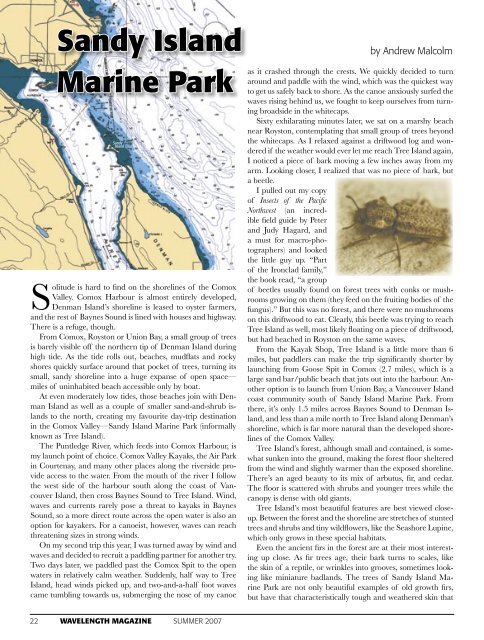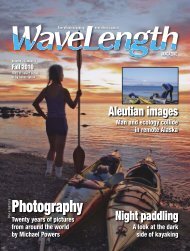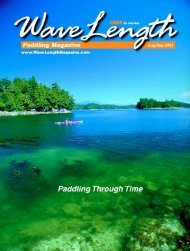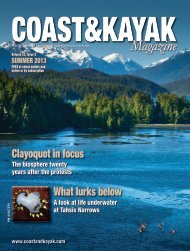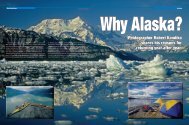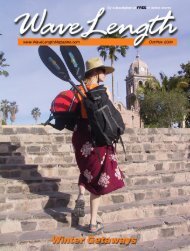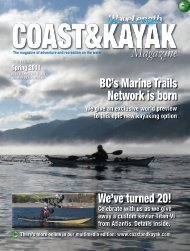download - Wavelength Paddling Magazine
download - Wavelength Paddling Magazine
download - Wavelength Paddling Magazine
Create successful ePaper yourself
Turn your PDF publications into a flip-book with our unique Google optimized e-Paper software.
Sandy Island<br />
Marine Park<br />
Sandy<br />
Island<br />
Solitude is hard to find on the shorelines of the Comox<br />
Valley. Comox Harbour is almost entirely developed,<br />
Denman Island’s shoreline is leased to oyster farmers,<br />
and the rest of Baynes Sound is lined with houses and highway.<br />
There is a refuge, though.<br />
From Comox, Royston or Union Bay, a small group of trees<br />
is barely visible off the northern tip of Denman Island during<br />
high tide. As the tide rolls out, beaches, mudflats and rocky<br />
shores quickly surface around that pocket of trees, turning its<br />
small, sandy shoreline into a huge expanse of open space—<br />
miles of uninhabited beach accessible only by boat.<br />
At even moderately low tides, those beaches join with Denman<br />
Island as well as a couple of smaller sand-and-shrub islands<br />
to the north, creating my favourite day-trip destination<br />
in the Comox Valley—Sandy Island Marine Park (informally<br />
known as Tree Island).<br />
The Puntledge River, which feeds into Comox Harbour, is<br />
my launch point of choice. Comox Valley Kayaks, the Air Park<br />
in Courtenay, and many other places along the riverside provide<br />
access to the water. From the mouth of the river I follow<br />
the west side of the harbour south along the coast of Vancouver<br />
Island, then cross Baynes Sound to Tree Island. Wind,<br />
waves and currents rarely pose a threat to kayaks in Baynes<br />
Sound, so a more direct route across the open water is also an<br />
option for kayakers. For a canoeist, however, waves can reach<br />
threatening sizes in strong winds.<br />
On my second trip this year, I was turned away by wind and<br />
waves and decided to recruit a paddling partner for another try.<br />
Two days later, we paddled past the Comox Spit to the open<br />
waters in relatively calm weather. Suddenly, half way to Tree<br />
Island, head winds picked up, and two-and-a-half foot waves<br />
came tumbling towards us, submerging the nose of my canoe<br />
by Andrew Malcolm<br />
as it crashed through the crests. We quickly decided to turn<br />
around and paddle with the wind, which was the quickest way<br />
to get us safely back to shore. As the canoe anxiously surfed the<br />
waves rising behind us, we fought to keep ourselves from turning<br />
broadside in the whitecaps.<br />
Sixty exhilarating minutes later, we sat on a marshy beach<br />
near Royston, contemplating that small group of trees beyond<br />
the whitecaps. As I relaxed against a driftwood log and wondered<br />
if the weather would ever let me reach Tree Island again,<br />
I noticed a piece of bark moving a few inches away from my<br />
arm. Looking closer, I realized that was no piece of bark, but<br />
a beetle.<br />
I pulled out my copy<br />
of Insects of the Pacific<br />
Northwest (an incredible<br />
field guide by Peter<br />
and Judy Hagard, and<br />
a must for macro-photographers)<br />
and looked<br />
the little guy up. “Part<br />
of the Ironclad family,”<br />
the book read, “a group<br />
of beetles usually found on forest trees with conks or mushrooms<br />
growing on them (they feed on the fruiting bodies of the<br />
fungus).” But this was no forest, and there were no mushrooms<br />
on this driftwood to eat. Clearly, this beetle was trying to reach<br />
Tree Island as well, most likely floating on a piece of driftwood,<br />
but had beached in Royston on the same waves.<br />
From the Kayak Shop, Tree Island is a little more than 6<br />
miles, but paddlers can make the trip significantly shorter by<br />
launching from Goose Spit in Comox (2.7 miles), which is a<br />
large sand bar/public beach that juts out into the harbour. Another<br />
option is to launch from Union Bay, a Vancouver Island<br />
coast community south of Sandy Island Marine Park. From<br />
there, it’s only 1.5 miles across Baynes Sound to Denman Island,<br />
and less than a mile north to Tree Island along Denman’s<br />
shoreline, which is far more natural than the developed shorelines<br />
of the Comox Valley.<br />
Tree Island’s forest, although small and contained, is somewhat<br />
sunken into the ground, making the forest floor sheltered<br />
from the wind and slightly warmer than the exposed shoreline.<br />
There’s an aged beauty to its mix of arbutus, fir, and cedar.<br />
The floor is scattered with shrubs and younger trees while the<br />
canopy is dense with old giants.<br />
Tree Island’s most beautiful features are best viewed closeup.<br />
Between the forest and the shoreline are stretches of stunted<br />
trees and shrubs and tiny wildflowers, like the Seashore Lupine,<br />
which only grows in these special habitats.<br />
Even the ancient firs in the forest are at their most interesting<br />
up close. As fir trees age, their bark turns to scales, like<br />
the skin of a reptile, or wrinkles into grooves, sometimes looking<br />
like miniature badlands. The trees of Sandy Island Marine<br />
Park are not only beautiful examples of old growth firs,<br />
but have that characteristically tough and weathered skin that<br />
22 WAVELENGTH MAGAZINE SUMMER 2007


